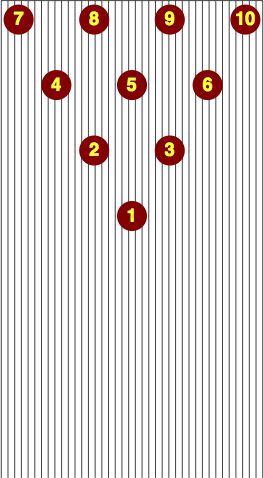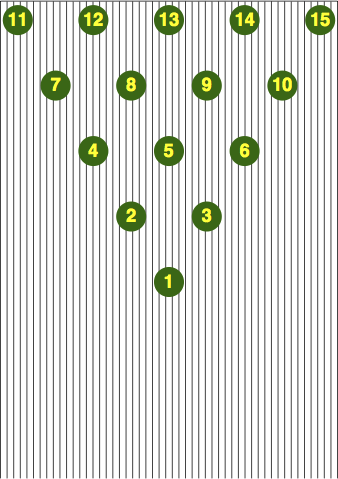The following table details, in parallel columns to emphasize the analogy, the usual 10-pin game (left) and this 15-pin variation (right).
| The traditional ten-pin game
| Bowling-and-a-half
|
| Pins and lane.
|
|---|

10 pins are arranged in a triangle, at a center-to-center distance of 12 inches, their positions numbered for reference.
The lane, 41½ inches wide, is traditionally constructed of 39 boards each slightly more than one inch wide. The length of the lane is 60 feet from foul line to the center of the number-1 pin. Additionally, there is an approach area at least 15 feet long of the same width as the lane.
| 
15 pins are arranged in a triangle, at a center-to-center distance of 12 inches, their positions numbered for reference.
The lane, 53½ inches wide, would be constructed of 51 boards each slightly more than one inch wide. The length of the lane is as desired.
|
| Length of game. |
|---|
| 10 frames
| 15 frames
|
| All frames except the last.
|
|---|
| In each of the 1st through 9th frames,
a bowler is presented a full rack of 10 pins, and rolls the ball 1 or 2 times.
| In each of the 1st through 14th frames,
a bowler is presented a full rack of 15 pins, and rolls the ball 1, 2, or 3 times.
|
A strike is recorded when all pins are felled on the first roll.- The frame ends.
- Earned are 10 points plus a bonus equal to the combined pinfall of the next 2 rolls, which will occur in the next 1 or 2 frames.
| A star is recorded when all pins are felled on the first roll.- The frame ends.
- Earned are 15 points plus a bonus equal to the combined pinfall of the next 3 rolls, which will occur in the next 1, 2, or 3 frames.
|
A spare is recorded when at least 1 pin was standing after the 1st roll,
but all remaining pins were felled on the 2nd roll.
- The frame ends.
- Earned are 10 points plus a bonus equal to the pinfall of the next roll,
which will occur in the next frame.
| A strike is recorded when at least 1 pin was standing after the 1st roll,
but all remaining pins were felled on the 2nd roll.
- The frame ends.
- Earned are 15 points plus a bonus equal to the pinfall of the next 2 rolls,
which will occur in the next 1 or 2 frames.
|
An open frame is recorded when at least 1 pin was standing after the 2 rolls.
- The frame ends.
- Earned is 1 point for each pin felled, with no bonus.
| A spare is recorded when at least 1 pin was standing after the 1st and 2nd rolls,
but all remaining pins were felled on the 3nd roll.
- The frame ends.
- Earned are 15 points plus a bonus equal to the pinfall of the next roll,
which will occur in the next frame.
|
|
| An open frame is recorded when at least 1 pin was standing after the 3 rolls.
- The frame ends.
- Earned is 1 point for each pin felled, with no bonus.
|
| Marks.
|
|---|
A strike or spare is a mark.
- If no pins are felled on the 1st roll, but all 10 on the 2nd roll, it counts as only a spare.
| A star, strike, or spare is a mark.
- If no pins are felled on the 1st roll, but all 15 on the 2nd roll, it counts as only a strike.
- If no pins are felled on the 1st and 2nd rolls, but all 15 on the 3rd roll, it counts as only a spare.
|
| Last frame.
|
|---|
| In the 10th frame, the bowler is presented a full rack of 10 pins, and rolls the ball 2 or 3 times.
If all 10 pins are felled on the 1st roll, it is a strike, and the bowler gets 2 addtional rolls.
… otherwise …
If all remaining pins are felled on the 2nd roll, it is a spare, and the bowler gets 1 addtional roll.
… otherwise …
It is an open frame, and the bowler does not get a 3rd roll.
| In the 15th frame, the bowler is presented a full rack of 15 pins, and rolls the ball 3 or 4 times.
If all 15 pins are felled on the 1st roll, it is a star, and the bowler gets 3 addtional rolls.
… otherwise …
If all remaining pins are felled on the 2nd roll, it is a strike, and the bowler gets 2 addtional rolls.
… otherwise …
If all remaining pins are felled on the 3rd roll, it is a spare, and the bowler gets 1 addtional roll.
… otherwise …
It is an open frame, and the bowler does not get a 4th roll.
|
| Whenever the bowler is entitled to another roll but no pins are standing, a fresh rack of 10 pins is provided.
As before, felling all of them on the 1st try counts as a strike,
and in 2 tries (if 2 rolls remain) a spare.
| Whenever the bowler is entitled to another roll but no pins are standing, a fresh rack of 15 pins is provided.
As before, felling all of them on the 1st try counts as an star,
on 2 tries (if 2 rolls remain) a strike,
and on 3 tries (if 3 rolls remain) a spare.
|
| Earned is 1 point for each pin felled in this frame; no bonuses are earned for marks.
Still, pins felled in the 10th frame can fulfill bonuses earned in the 8th and 9th frames.
| Earned is 1 point for each pin felled in this frame; no bonuses are earned for marks.
Still, pins felled in the 15th frame can fulfill bonuses earned in the 12th, 13th and 14th frames.
|
The 10th is the only frame in which a bowler can earn more then 1 mark. The multi-mark combinations are:
- 3 strikes
- 2 strikes
- 1 strike and 1 spare
| The 15th is the only frame in which a bowler can earn more then 1 mark. Some of the multi-mark combinations are:
- 2, 3, or 4 stars
- 1 star and 1 strike
- 2 strikes
|
| Perfect score. |
|---|
| 300 = 10 × 30, requiring 12 rolls
| 900 = 15 × 60, requiring 18 rolls
|
Notes.
This idea can be extended to other numbers of pins.
All pins are of equal scoring value. In other members of the broader bowling family, some pins are worth more than others (e.g. five-pin), or there is a bonus for felling certain combinations of pins (e.g. nine-pin).
Between any two rolls within a frame, all pins that have been felled are cleared away, giving the bowler unobstructed access to the pins that remain standing. Some other varieties of bowling (e.g. candlepin) leave this "deadwood" on the lane, which an experienced player can sometimes use to advantage in felling the remaining standing pins.
Somewhat simpler is a circular method of scoring. The final frame would be handled exactly like the other frames, with any bonuses earned in the final frame(s) to be calculated based upon the first frame(s). Here is an example from the ten-pin game. If a bowler rolls a strike to begin the 10th frame, the game ends immediately, and the two-roll bonus would be calculated based on the rolls on the 1st and possibly 2nd frames. One consequence is that a perfect game would require 10 strikes rather than 12, making it considerably easier.
|
As a detailed example, here is the scoring of a complete game of bowling-and-a-half, followed by a frame-by-frame description of how it is calculated:
In accordance with bowling tradition, marks are denoted by special symbols with the number of strokes equalling the number of bonus rolls:
In the table below, subscripts appear in the arithmetic to explain where the numbers come from. Within each subscript:
|
| Frame 1
3 - 6 - 4
no mark
| 131T = 31A + 61B + 41C
|
|
| Frame 2
5 - 7 - 3
spare
| In place of the numeral 3 is a horizontal line, symbolizing the completion of a spare.
|
|
| Frame 3
11 - 2 - 1
no mark
| 392T = 131T + 52A + 72B + 32C + 113A
533T = 392T + 113A + 23B + 13C
|
|
| Frame 4
9 - 6
strike
| In place of the numeral 6 is an X, symbolizing the completion of a strike. Because of this strike there is no third roll in this frame, and the third box is left blank.
|
|
| Frame 5
4 - 11
strike
| 834T = 533T + 94A + 64B + 45A + 115B
|
|
| Frame 6
0 - 0 - 15
spare
| 985T = 834T + 45A + 115B + 06A + 06B
Although all 15 pins were felled in one roll, it was not the first roll of the frame, so this does not count as a star.
|
|
| Frame 7
15
star
| 1286T = 985T + 06A + 06B + 156C + 157A
In place of the numeral 15 is an asterisk, symbolizing the achievement of a star. This frame will not have a second or third roll.
|
|
| Frame 8
15
star
| The 7th-frame star awaits two rolls, while that of the 8th awaits three. This illustrates that multiple frames might be awaiting later-frame rolls for calculation of scores.
|
|
| Frame 9
8 - 7
strike
| 1737T = 1286T + 157A + 158A + 89A + 79B
The star awaits one roll, the strike two.
|
|
| Frame 10
1 - 0 - 13
no mark
| 2048T = 1737T + 158A + 89A + 79B + 110A
2209T = 2048T + 89A + 79B + 110A + 010B
23410T = 2209T + 110A + 010B + 1310C
|
|
| Frame 11
14 - 0 - 1
spare
| The spare awaits one roll.
|
|
| Frame 12
12 - 3
strike
| 26111T = 23410T + 1411A + 011B + 111C + 1212A
The strike awaits two rolls.
|
|
| Frame 13
15
star
| The strike awaits one roll, and the star awaits three.
|
|
| Frame 14
10 - 4 - 1
spare
| 30112T = 26111T + 1212A + 312B + 1513A + 1014A
33113T = 30112T + 1513A + 1014A + 414B + 114C
|
|
| Frame 15
6 - 9 - 12 - 2
one strike
| 35214T = 33113T + 1014A + 414B + 114C + 615A
38115T = 35214T + 615A + 915B + 1215C + 215D
|
Here are three other ways the last frame of the game above might have turned out:
































 ,
,  , and
, and  indicate how many rolls must take place in future frames before the score for this frame can be calculated.
indicate how many rolls must take place in future frames before the score for this frame can be calculated.